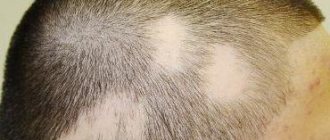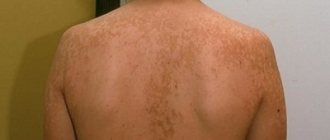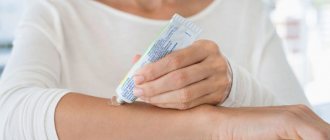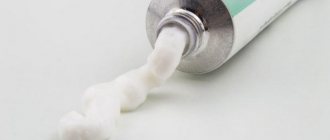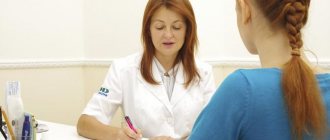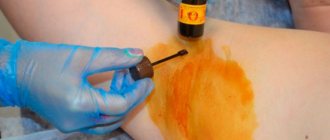Causes of lichen
The diagnosis of “lichen” is made on the basis of the clinical picture - small rashes that rise slightly above the skin level and look like a localized area of rash with clear contours (Fig. 1).
Figure 1. Plaques of pityriasis rosea usually have a clear outline. Source: PHIL CDC
Since we are talking about various diseases, the causes of lichen may be different. Most variants of pathology occur due to exposure to harmful microorganisms (viruses, fungi, bacteria), which are especially active against the background of weakened immunity. In some cases, contact with sick animals plays a decisive role. For certain types of deprivation, the question of the reasons for development still remains open - there are hypotheses that require further study.
Predisposing factors for the development or exacerbation of the disease are:
- stressful influences,
- hypothermia,
- previous infections,
- failure to comply with hygiene rules.
The risk group includes both children and adults who have a decrease in immune defense, hormonal imbalances, and neurological disorders. The hereditary factor is considered only for some types of lichen with an unknown infectious cause of development.
All types of lichen that occur due to exposure to microorganisms on the body are transmitted by contact and are therefore considered quite contagious. For other variants of the disease, there is no convincing data on the danger to others.
Types of lichen
Depending on the cause of development and characteristics of manifestation, several variants of lichen are distinguished:
- Pityriasis rosea (Giber's disease). The disease is characterized by a viral nature - the cause of pityriasis rosea is considered to be herpes viruses types 6 and 7.
- Shingles (herpes zoster). Origin - the herpes virus (Herpes Zoster), which causes chickenpox in childhood. Often appears after hypothermia, the rash is usually localized in the direction of the nerves.
- Pityriasis versicolor (variegated, solar) lichen. Occurs due to the action of a fungus of the Malassezia species. The peak of the disease is the summer season; infection often occurs on the beach, in shared showers. Without proper treatment, it can become chronic.
- Ringworm. Most often diagnosed in children. The cause of the disease is fungi of the Microsporum and Trichophyton species, which can be transmitted from sick people or animals.
- Lichen planus. It occurs quite rarely, its appearance is not associated with infection. The cause is considered to be autoimmune reactions of the body.
- Scaly lichen (psoriasis). It also does not apply to infectious and “contagious” lichen; the reasons for its development are still unknown. One of the theories discussed is an autoimmune variant of the disease - systemic damage to connective tissue. Characterized by seasonality, deterioration after stress. Increases the risk of developing arthritis and other systemic manifestations of autoimmune disease.
Lichens of infectious origin with contact transmission also differ in the degree of “infectiousness” (Table 1).
Table 1. The degree of infectivity of various types of lichen.
| Type of lichen | Contagiousness degree |
| Shearer | The tallest |
| Pink | Low (there is an opinion that lichen is not contagious) |
| girdling | High, especially in the phase of active rashes |
| Pityriasis | Low (there is an opinion that lichen is not contagious) |
Shingles
Another type of lichen is shingles. Its causative agent is also the herpes virus. And the specific one is zoster. It can be distinguished by the location of skin lesions. They correspond to the location of human nerve trunks.
The most serious problem is that the incubation period for shingles in humans can be several decades. Moreover, even if a person is a carrier of the virus, he may not be susceptible to it. Most often, this disease occurs in mature and elderly people. In medicine, there have been no recorded cases of infection in children under 10 years of age.
This type of lichen is not spread by airborne droplets. You can only catch the virus through close and direct contact. People who have not had chickenpox in childhood should be especially careful.
Symptoms and manifestations
The rash of lichen is accompanied by a change in skin color (redness), moderate or severe itching and peeling. The appearance of scales can be isolated, or may be associated with constant scratching of itchy areas. If the outbreak is localized on the scalp, hair loss occurs in this area. It is important that the elements of the rash do not transform into others, but retain their appearance until the lichen is cured.
Although skin symptoms for different types of lichen are similar, they often differ in location and additional manifestations:
- Pityriasis rosea. Spots on the skin up to 10 cm in diameter acquire a pink tint, and the rash is accompanied by peeling. There is usually no itching or pain. Typical localization is limbs, groin area. On average, the disease goes away in 3–8 weeks; with the right approach to treatment, complications are unlikely.
- Shingles. Rashes most often appear along the intercostal nerves, accompanied by itching and pain - neuralgia. With proper treatment, symptoms disappear within 2–4 weeks; in the absence of antiherpetic therapy, the disease can be complicated by severe damage to the nervous system.
- Pityriasis versicolor. The rash is characterized by pinkish and yellow-brown spots without itching. Typical localization is the skin of the chest, back and shoulders. If you follow medical recommendations, the rashes disappear within 2–3 weeks, leaving no serious consequences.
- Ringworm. Localization of the rash is the scalp, areas of smooth skin, and nails. The hair at the site of the lesion takes on the appearance of being cut off, and a white coating appears on the skin. The incubation period of the disease lasts up to 1.5 months, and the duration of treatment can be up to 6 weeks. Typically, ringworm goes away without complications.
- Lichen planus. It is distinguished by a rash in the form of dense elevations with a characteristic depression in the center, the color of the rash is red with a purple tint. The acute form of the disease disappears in a few weeks, the subacute form lasts up to 6 months and can turn into a chronic process. Possible complications of the pathology are associated with the addition of an infection, a mental reaction to constant itching and the risk of developing squamous cell skin cancer in the absence of proper treatment.
- Squamous lichen. Psoriasis is a chronic disease that manifests itself differently depending on the extent of the skin damage. The main element of the rash is voluminous spots with white scales without itching, cracks due to a violation of the integrity of the skin. The skin of patients takes on a repulsive appearance, and due to the disease, the risk of arthritis, pathologies of the cardiovascular and nervous systems, and the gastrointestinal tract increases significantly.
In addition to characteristic changes on the skin (Fig. 2), lichen often manifests itself as weakness, deterioration of health, and even fever.
Figure 2. Some types of lichen. Source: ResearchGate, PHIL CDC
Treatment of lichen
Treatment of pityriasis rosea
Usually, pityriasis rosea does not require drug treatment, as it goes away on its own. During illness you need:
- follow a hypoallergenic diet;
- limit water treatments;
- do not use cosmetics;
- wear underwear made from natural fabrics.
If the patient complains of itchy skin, he is prescribed:
- antihistamines;
- hormonal creams and ointments containing boric acid/zinc;
- hyposensitizing drugs.
Effective methods of non-drug therapy include exposure of the skin to UV radiation with a wavelength of 280-320 nm.
Treatment of herpes zoster
Treatment of herpes zoster in children and adults involves the use of Virolex, Acyclovir, Zovirax. These drugs are effective at the very beginning of the disease. Additionally, Curantil and Furosemide are prescribed. Intravenous administration of immunoglobulin, which activates immunogenesis, helps to achieve good results.
Depending on the severity of the disease, the patient may be recommended symptomatic therapy, which consists of taking:
- general health-improving medications (B vitamins);
- analgesics;
- antipyretic tablets.
Sedatives help with sleep disorders. In some cases, taking antidepressants is indicated. In case of pronounced intoxication of the body, detoxification measures are carried out with forced diuresis.
Locally, lesions of herpes zoster can be treated with a solution of brilliant green, five percent dermatol ointment. For a sluggish form of the disease, metacil ointment and Solcoseryl are used. Areas of skin with rashes can be affected locally using quartz, UV irradiation, and laser.
Treatment of pityriasis versicolor
Treatment of pityriasis versicolor is carried out on an outpatient basis. Antifungal agents are effective against the pathogen:
- salicylic alcohol (3-5%);
- salicylic ointment (5%);
- sulfur ointment (5-10%);
- resorcinol alcohol (3-5%);
- Bifazol;
- Miconazole;
- Cycloperox;
- Naftifin;
- Lamisil et al.
If the lesions are spread throughout the body, oral administration of Orungal, Itraconazole, and Ketonazole is preferable.
Treatment of ringworm
If possible, the treatment of ringworm should be limited to the use of topical medications. If only smooth skin is involved in the pathological process (hair follicles are not affected), you can alternately treat the lesions with an iodine-containing solution and antifungal ointment (Microspor, Lamisil, Exoderil).
For severe skin inflammation, oral antifungal medications are recommended. The optimal triazole derivatives are Itrazyl, Irunin. It is best to shave or trim the hair in the ringworm area.
If suppuration forms on the surface of the lesion, it must be removed by first softening the scabs with salicylic ointment or a solution of potassium permanganate. At the infiltrate stage, ichthyol ointment and Liniment according to Vishnevsky can be used.
Additional methods of treating ringworm include vitamin therapy, as well as taking medications aimed at strengthening the immune system.
Treatment of lichen planus
Treatment of lichen planus is aimed at eliminating itching and burning. The patient may be prescribed:
- Tavegil;
- Suprastin;
- Zyrtec.
Selective phototherapy or PUVA therapy using photosensitizers helps achieve good results. It is also possible to take combined antimalarials (Plaquenil, Delagil) and corticosteroids (Diprospan, Prednisolone).
Local therapy for lichen planus is usually not carried out. If mucous membranes are involved in the pathological process, they should be treated with Rotokan, Solcoseryl, corticosteroid ointments and vegetable oils. If a secondary infection occurs, antibiotics are prescribed.
Diagnostics
Sometimes, to determine the type of lichen, an external examination and collection of anamnesis is enough - a history of the development of symptoms of the disease and possible connections with risk factors (hypothermia, contact with pets). But in some cases, the diagnostic search turns out to be more difficult.
To correctly determine the type of lichen, the dermatologist carries out:
- visual inspection;
- examination using a Wood's lamp (“black lamp”);
- examination of scraping damaged skin under a microscope.
Also, to assess the general state of health, doctors often prescribe blood and urine tests, and a study of the immunological status.
Diagnosis and treatment of ringworm
Before starting treatment, you need to make a correct diagnosis. Differential diagnosis is carried out by a dermatologist based on the patient’s complaints and existing symptoms.
In ringworm, the plaques are round, edged with vesicles or scales, and have a reddish spot in the center. To distinguish trichophytosis from other skin diseases, the spots are irradiated with a Wood's lamp. The illuminated lichen lesion has a bluish-green color. When skin particles are inoculated in the laboratory, “fluffy” colonies of the fungus grow.
Additionally, a special analysis is taken using the scraping method to determine the type of fungus.
Treatment of lichen in adults and children
Glucocorticosteroid creams are effective against shingles caused by herpesvirus infection.
Photo: AGLPhotoproduction/Depositphotos Therapy for each of the variants of this group of diseases depends primarily on the cause of the lichen, as well as on the severity of the changes. In adults and children, treatment regimens are almost the same, only in childhood the dosages of drugs may change, and some “adult” drugs are prohibited for use at an early age.
Treatment of the main variants of the disease:
- Therapy for pathologies caused by the herpes virus (pink and herpes zoster) is reduced to the prescription of antiherpetic drugs (acyclovir), anti-inflammatory and antiallergic drugs (antihistamine tablets), as well as the use of local steroidal anti-inflammatory ointments.
- Fungal types of pathology (pityriasis versicolor) are treated with antifungal, antimycotic ointments.
- To quickly treat ringworm, you need to get rid of the hair and then use antifungal ointments. Between applications of medicinal compositions, it is necessary to lubricate the stains with iodine.
For types of disease with unknown causes, specific treatment regimens have not been developed; therapy is selected individually. There is information about the incurability of scaly lichen - only an asymptomatic course of the disease is possible.
Self-medication: consequences and dangers
Scratching the rash can cause scars to form on the skin.
Photo: LaCameraChiara / Depositphotos Treatment of lichen without the help of doctors most often turns out to be ineffective - it is almost impossible to independently determine the exact cause of the disease. Self-medication can also be dangerous - for example, erroneous use of antibiotics for herpes zoster not only affects the manifestation of a viral disease, but also causes a toxic effect on the body and the development of antibiotic resistance in the future. A common complication of herpes zoster is postherpetic neuralgia. If you do not consult a doctor in a timely manner, any of the variants of the disease can progress, become more difficult to treat, become a chronic pathology and cause the formation of irreversible changes on the skin - scars.

